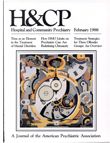Care of Children With Psychiatric Disorders at Community Hospitals
Abstract
Short-term general hospitals account for most psychiatric hospitalizations of children, but relatively little research has examined the psychiatric care of children at these facilities. This study compared the characteristics of and use of hospital services by children and adults who received a primary psychiatric diagnosis at 380 short-term general hospitals in 1977. Of the 100,000 patients studied, 7,000, or 7 percent, were children, most between the ages of 12 and 17. Children 12 and older were hospitalized the longest, a mean of 15.6 days, followed by adults (12.7 days), children between six and 11 (10.7 days), and children five and younger (5.6 days). The great majority of children under age 12 and roughly one-third of children between ages 12 and 1 7 were not seen by a psychiatrist during their hospital stay. Very few were seen by child psychiatrists. The authors believe that child psychiatrists should be concerned about the effect their relative absence from general hospitals has on quality of care.
Access content
To read the fulltext, please use one of the options below to sign in or purchase access.- Personal login
- Institutional Login
- Sign in via OpenAthens
- Register for access
-
Please login/register if you wish to pair your device and check access availability.
Not a subscriber?
PsychiatryOnline subscription options offer access to the DSM-5 library, books, journals, CME, and patient resources. This all-in-one virtual library provides psychiatrists and mental health professionals with key resources for diagnosis, treatment, research, and professional development.
Need more help? PsychiatryOnline Customer Service may be reached by emailing [email protected] or by calling 800-368-5777 (in the U.S.) or 703-907-7322 (outside the U.S.).



